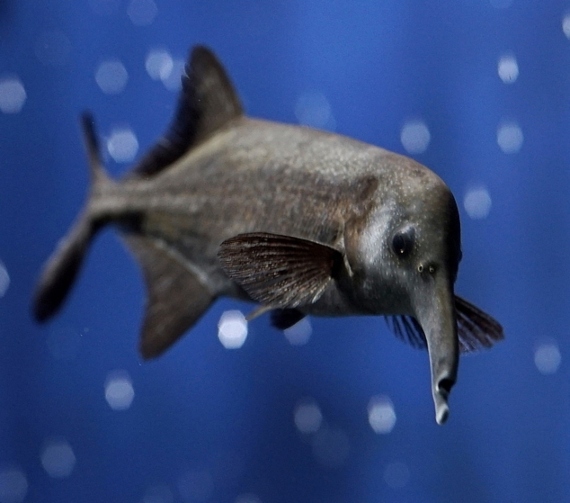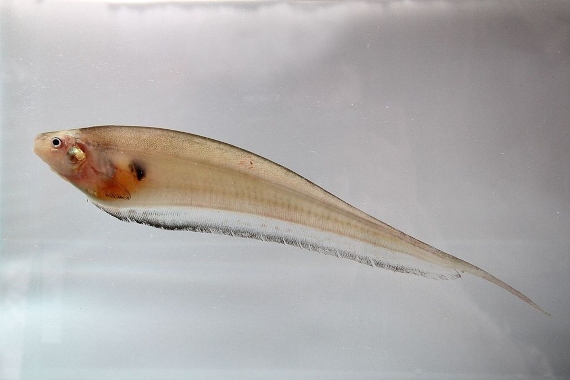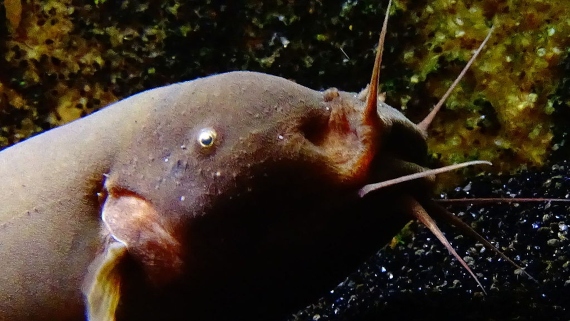Platypuses, echidnas and bumblebees are extraordinary examples of land animals that can sense electric fields and use them to detect prey or communicate. But it is only under water that creatures are able to take these animal superpowers further and generate their own electricity. Around 400 species of electric fishes are known today. The incredible ability to produce electricity has fascinated humans since ancient times and now inspires novel medical therapies and energy-producing technologies.

Peters’s elephantnose fish (Gnathonemus petersii)
Electrogenic (or electricity-producing) fishes are divided into two main groups based on the voltage of their electrical discharges: strongly electric fish, capable of producing discharges of up to hundreds of volts, and weakly electric fish that generate discharges of just one volt or less. The vast majority of known electric fish species fall into the latter category. One of these is the Peters’s elephantnose fish, a nocturnal fish of up to 35cm long, which, like the other weakly electric fish, inhabits fresh waters in tropical regions—in this case, West and Central Africa.
Weakly electric fish use their electrogenerating capacity to communicate with each other, to orient themselves and to navigate, thereby counteracting the poor visibility of the murky, sediment-laden waters they inhabit. This navigation system, known as electrolocalisation, operates like a kind of electrical sonar: the fish’s electrogenerator organ, located in its tail, constantly emits small electrical signals or pulses. The presence of an object or animal in the vicinity distorts these signals, a disturbance that the fish detects thanks to electroreceptors distributed over the entire surface of its body. Communication occurs when this electrical signal reaches a fellow fish, which recognises it. As the fish also generates its own mini-charges continuously, the communication works both ways.

Glass knifefish (Eigenmannia sp)
At the end of 2020, the discovery of a new species of glass knifefish inhabiting the interior of the Sao Vicente caves in the Brazilian Amazon basin was announced. The new species, consisting exclusively of 300 individuals and named Eigenmannia vicentespelea, has evolved by adapting to conditions of total darkness. The result is a blind and albino species, but with electrical organs that are more powerful than those of its conspecifics, enabling it to navigate and locate its prey, and to communicate with each other at a distance of several metres, an impressive feat for a fish just 10cm in length.
This discovery seems to provide an answer to one of the questions raised by experts regarding electric fish: how they would adapt to such a habitat, whether by boosting their electrical capacity or, in contrast, by reducing it to minimise energy expenditure in an environment where food resources are limited.

Electric catfish (Malapterurus electricus)
The electric catfish, which inhabits the waterways of tropical Africa and the Nile, is one of the few strongly electric fish—capable of generating discharges of hundreds of volts—which, in its case, exceed 350 volts and enable it to stun its prey.
All electrogenic fish, both weak and strong, generate these discharges thanks to specific organs in which special disc-shaped cells—the electrocytes—are grouped; these fish have the ability to modify the distribution of charge inside the cells so that one side of the cell becomes positively charged and the other side negatively charged. The cell acts like a battery, with each electrocyte producing a current of about 150 mV. In electrogenic organs, these electrocytes are stacked together, separated from each other by a layer of insulating proteins and arranged in series, so that when discharged simultaneously their individual voltages are added together, increasing the current.
In weakly electric fish, the small generating organ is located in the tail. In strongly electric fish, these organs contain large numbers of electrocytes, are much bigger in size and occupy a significant portion of the animal’s body.

Electric skate or torpedo ray (order Torpediniformes)
Unlike most electric fish, which inhabit fresh waters, electric rays live in shallow coastal waters. They use the shocks they are able to generate of up to 200 volts to stun prey or as a defence mechanism.
The ability of these rays to generate electric shocks has been known since ancient times. In fact, both the Greeks and later the Romans used them to numb and sedate patients during surgery and also to treat ailments such as gout and migraines.
The Egyptians, for their part, used electric catfish as a therapeutic element for various ailments such as arthritis, as reflected in the wall paintings of the time. However, only small or young specimens were used, in order to limit the effects of the shock.
Electric eel (Electrophorus voltai)
There is no doubt that the electric eel is the electrogenic animal par excellence. Strangely enough, however, it only looks like an eel; it is actually a kind of knife fish. For two and a half centuries it was thought to be a single species, but in 2019 the discovery of two new species was announced.
The well-known Electrophorus electricus has now been joined by Electrophorus varii and Electrophorus voltai—the latter capable of generating electrical discharges of up to 850 volts, more than 200 volts higher than the highest recorded by any other fish, thanks to larger electrogenic organs.
All three species are endemic to the Amazon basin, but each is restricted to its own distribution and habitat. E. voltai live in fresher, clearer waters (with less suspended particles), where electrical conductivity is lower, and this may explain the greater size and power of its “batteries”.
The unparalleled ability of electric eels to generate high-voltage discharges lies in their three electrical organs: the main organ, Sachs’ organ and Hunter’s organ. They work together and occupy four-fifths of their elongated body, which in adult eels reaches 2.5 metres.
Thousands of stacked electrocytes are concentrated in these organs, separated from each other by layers of insulating proteins. This structure inspired Alessandro Volta to design his battery in 1800, the first electric battery in history, consisting of a column of metal discs separated by layers of paper soaked in a saline solution.
And in 2017, this same structure also inspired Swiss researchers to make a novel battery, consisting of a specially folded plastic sheet covered with droplets filled with hydrogels with different electrical charges. The design promises to have future application in medical implants such as insulin pumps or electrostimulators, and also in so-called “soft robots”.
Miguel Barral
Comments on this publication